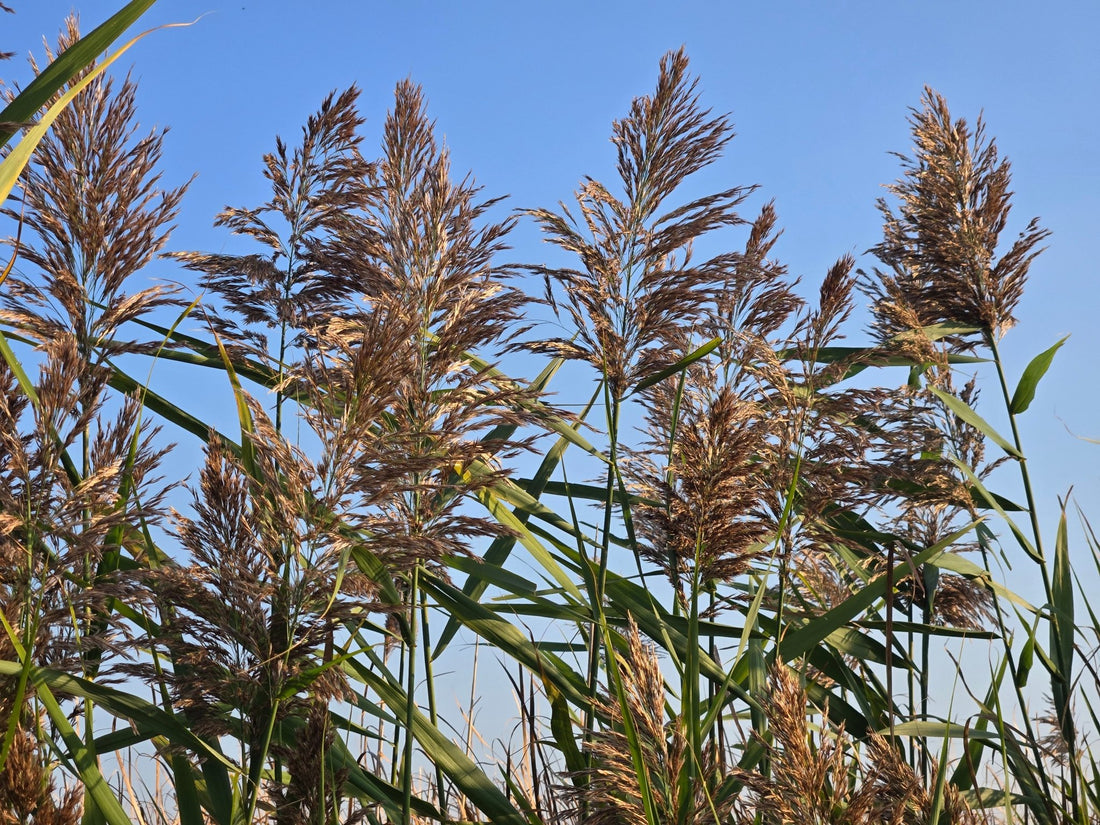Beware the Phragmites: Georgina's Pesky Invader
If you’ve got a wetland, marsh, roadside ditch, or really any damp area in Georgina, there’s a good chance you’ve crossed paths with Phragmites. This invasive plant, also known as European Common Reed, may look like a beautiful addition to the scenery with its towering stalks and feathery plumes, but don’t be fooled—it’s the garden world’s equivalent of an unwelcome guest that never leaves.
What is Invasive Phragmites?
Invasive Phragmites (Phragmites australis) is a tall, reed-like grass native to Europe that was introduced to North America, likely hitching a ride in ships’ ballast water or in contaminated plant materials. Since arriving, it’s decided that it’s going to take over wetlands, shorelines, and any soggy area it can root into. Unlike its native cousin (Phragmites australis subsp. americanus), which behaves like a good neighbour, this invasive version chokes out native species, degrades wildlife habitats, and clogs up waterways.

Where to Find It
Phragmites is everywhere—seriously. You can find this menace in roadside ditches, along lake shores, wetlands, and even in disturbed areas that have a bit too much moisture. Phragmites is especially fond of the Great Lakes region but is spreading its roots far and wide. If you’re driving and see a dense stand of tall, golden-brown grass growing taller than any plant has the right to, it’s probably Phragmites.
How to Identify It
Not sure if you’re dealing with Phragmites? Here’s your detective guide:
- Height: These giants can grow up to 5 meters tall (about 16 feet), so if your grass is towering over you, it’s likely Phragmites. Native Phragmites tends to be shorter and grows in smaller, less aggressive clusters.
- Stalks: Look for thick, hollow, and rigid stalks that are often tan in colour. They’ll snap like dry straw in the winter. Native Phragmites stems feel smoother.
- Leaves: The leaves are long and sword-shaped, up to 50 cm (20 inches) in length, and are blue-green in colour. Native Phragmites leaves are more yellow-green in colour.
- Seed Heads: The signature look of Phragmites is its fluffy, purple-tinged seed heads that turn into golden-brown tufts as they mature. These seed heads can grow over 30 cm (12 inches) long. Native Phragmites has a more delicate, light and open flower plume.
- Growth Pattern: Phragmites grows in dense stands, with dead stalks from the previous year forming thick barriers that other plants can’t penetrate.

What You Can Do About It
Now that you’ve ID’d this invader, what can you do to kick it out? Here’s the plan of action:
- Physical Removal: If you catch Phragmites early (when it’s still a smaller patch), pulling or digging it out can work. Make sure to remove the entire root system, as even the tiniest piece left behind can regrow. Best done in early summer.
- Cutting and Covering: For larger patches, cutting the stalks down close to the ground and covering the area with heavy black plastic or geotextile fabric can help smother new growth. This takes time—usually a full growing season.
- Herbicide: When physical removal isn’t feasible, targeted herbicide use is an option. Only approved herbicides should be used, and typically late summer or early fall is the best time for application when the plants are sending energy back to their roots.
- Water Level Management: Phragmites doesn’t like high water levels, so if you can raise the water table in a wetland, it may drown out the reeds. This is more for larger conservation projects but can be highly effective.
- Call the Experts: If you’ve got a serious infestation, it may be time to call in local conservation authorities or invasive species experts. They can help with large-scale management plans.
What Not to Do
When it comes to dealing with Phragmites, there are some major no-nos:
- Don’t Burn It: You might think fire is a quick way to deal with it, but burning Phragmites can make things worse. Its roots are incredibly resilient, and burning can create the perfect conditions for it to grow back stronger.
- Don’t Mow It: Mowing will spread the seeds around and, just like pulling out a hydra’s heads, it’ll come back even thicker if not dealt with properly. Plus, the seeds can hitch a ride on your mower to infest new areas.
- Don’t Ignore It: Once Phragmites has taken root, it spreads fast. Ignoring it won’t make it go away—it will only invade more of your space and threaten local ecosystems.
So, there you have it, invasive Phragmites is one of the most aggressive plants you’ll find in Georgina, and it’s not going to politely step aside. Whether it’s taking over a shoreline or creeping into your favourite marsh, it requires early action and ongoing management. While it may look like just another plant, remember—it’s a monster in disguise. So, get your gloves on, your tools ready, and show it who's boss!
Happy gardening!




